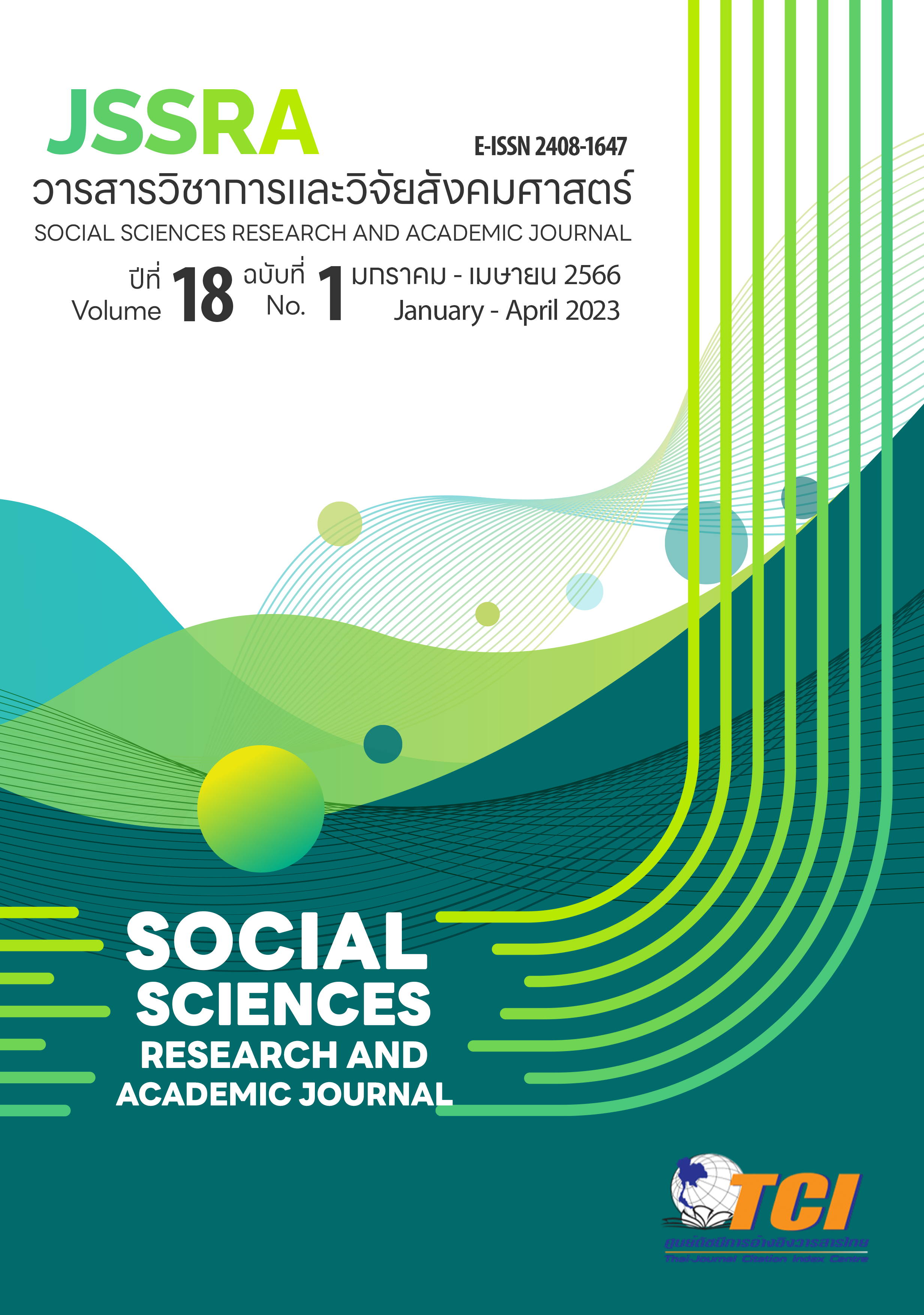การจัดการเรียนรู้ออนไลน์โดยใช้เทคนิคการคิดหมวกหกใบ เพื่อส่งเสริมความสามารถในการคิดอย่างมีวิจารณญาณ สำหรับนักศึกษาระดับบัณฑิตศึกษา Online Learning Management Based on Six Thinking Hats Technique to Promote Critical Thinking Ability for Graduate Students
Main Article Content
Abstract
The objectives of this study were to 1) compare the critical thinking ability of graduate students before and after online learning management using the six thinking hats technique, and 2) compare the critical thinking ability of graduate students after online learning management using the six thinking hats technique and a score of 70 percent. Cluster random sampling was used to select 27 graduate students from the Curriculum and Instruction program at the Faculty of Education, Nakhon Sawan Rajabhat University, in the third semester of Academic Year 2021. The research instruments consisted of 1) the 6 online lesson plans of six thinking hats technique which was at a high level (= 4.80, S.D.= 0.02) 2) critical thinking ability test with a 4 choice option including 30 items with difficulty ranging (p) from 0.25-0.66 a discriminatory ranging (r) from 0.25-0.56 and a precision value of 0.94 The data were analyzed in terms of means, standard deviation and dependent sample t-test and one sample t-test
The result were as follows: 1) Before online learning management using the six thinking hats technique, the average critical thinking ability score of graduate students was 10.33 with a standard deviation of 3.33. After online learning management, the average critical thinking ability score of graduate students was 23.67 with a standard deviation of 1.94. Meanwhile, the comparison of critical thinking ability after online learning management by using six thinking hats technique had average score higher than before management statistical significance at .05 level.
2) The graduate students' critical thinking ability after online learning management using the six thinking hats technique had an average score of 23.67 and a standard deviation of 1.94, which exceeded the criterion of 70% for a full score at the.05 level of statistical significance.
Article Details
References
กาญจนา เงารังสี. (ม.ป.ป). การสอนออนไลน์. สืบค้นเมื่อ 1 มิถุนายน 2565 จาก https://www.nu.ac.th/wp-content/uploads/2020/05/TeachOnline-04-2020.pdf
ชนาพร แสนสมบัติ. (2559). การสอนทักษะการคิดอย่างมีวิจารณญาณเพื่อการดำรงชีพในศตวรรษที่ 21. วารสารวิทยาลัยสงฆ์นครลำปาง, 5(2), 96-106.
ธนพร บุญประสิทธิ์. (2558). การพัฒนาความสามารถในการคิดอย่างมีวิจารณญาณโดยใช้การจัดการเรียนรู้ด้วยเทคนิคแบบหมวกหกใบ รายวิชาสุขศึกษา สำหรับนักเรียนขั้นมัธยมศึกษาปีที่ 1. วิทยานิพนธ์ปริญญาครุศาสตรมหาบัณฑิต สาขาวิชาหลักสูตรและการสอน. มหาวิทยาลัยราชภัฏพระนคร, กรุงเทพฯ.
ประพันธ์ศิริ สุเสารัจ. (2553). การพัฒนาการคิด. (พิมพ์ครั้งที่ 4). กรุงเทพฯ: เทคนิคพริ้นติ้ง.
ยุวดี สมศรี. (2551). การพัฒนาความสามารถในการคิดอย่างมีวิจารณญาณของนักเรียนชั้นมัธยมศึกษาปีที่ 3 โดยการจัดการเรียนรู้ด้วยเทคนิคหมวกหกใบ. วิทยานิพนธ์ปริญญาศึกษาศาสตรมหาบัณฑิต สาขาวิชาหลักสูตรและการนิเทศ. มหาวิทยาลัยศิลปากร, กรุงเทพฯ.
วันเพ็ญ ชาวสวนเจริญ. (2554). การศึกษาความสามารถในการคิดอย่างมีวิจารณญาณของนักเรียนชั้นมัธยมศึกษาปีที่ 2 โดยการจัดการเรียนรู้ด้วยเทคนิคหมวกหกใบ. วิทยานิพนธ์ปริญญาครุศาสตรมหาบัณฑิต สาขาวิชาหลักสูตรและการสอน. มหาวิทยาลัยราชภัฏนครปฐม, นครปฐม.
วิทยา วาโย และคณะ. (2563). การเรียนการสอนแบบออนไลน์ภายใต้สถานการณ์แพร่ระบาดของไวรัส COVID-19: แนวคิดและการประยุกต์ใช้จัดการเรียนการสอน. วารสารศูนย์อนามัยที่ 9, 14(34), 285-298.
วิภาดา พินลา. (2554). การศึกษาผลสัมฤทธิ์ทางการเรียนสังคมศึกษา ศาสนาและวัฒนธรรมและความสามารถในการคิดอย่างมีวิจารณญาณของนักเรียนชั้นมัธยมศึกษาปีที่ 2 ที่ได้รับการจัดการเรียนรู้แบบ 4MAT กับการจัดการเรียนรู้แบบหมวกคิด 6 ใบ. ปริญญานิพนธ์ การศึกษามหาบัณฑิต (การมัธยมศึกษา). มหาวิทยาลัยศรีนครินทรวิโรฒ, กรุงเทพฯ.
วรรณา การเฉื่อยเฉิน. (2560). การพัฒนากิจกรรมการเรียนรู้โดยใช้กระบวนการแบบวัฏจักรการเรียนรู้ทั้ง 7 ขั้นร่วมกับเทคนิคการคิดแบบหมวก 6 ใบเพื่อพัฒนาการคิดอย่างมีวิจารณญาณสำหรับนักเรียนชั้นมัธยมศึกษาปีที่ 6. วิทยานิพนธ์ปริญญาการศึกษามหาบัณฑิต สาขาวิชาหลักสูตรและการสอน. มหาวิทยาลัยนเรศวร, พิษณุโลก.
สำนักวิชาการและมาตรฐานการศึกษา. (2549). แนวทางการจัดการเรียนรู้เพื่อพัฒนาทักษะการคิดวิเคราะห์. (พิมพ์ครั้งที่2). กรุงเทพฯ: สำนักงานคณะกรรมการการศึกษาขั้นพื้นฐาน.
สมศรี วรรณขุนทด. (2557). ผลการใช้กิจกรรมการฝึกคิดแบบหมวกหกใบเพื่อพัฒนาการคิดอย่างมีวิจารณญาณของนักเรียนชั้นประถมศึกษาปีที่ 6. วิทยานิพนธ์ปริญญาศึกษาศาสตรมหาบัณฑิตสาขาวิชาจิตวิทยาการศึกษาและการให้คำปรึกษา. มหาวิทยาลัยขอนแก่น, ขอนแก่น.
สุพัตรา แย้มคลี่. (2548). การศึกษาผลสัมฤทธิ์ทางการเรียนและการคิดอย่างมีวิจารณญาณโดยใช้เทคนิคการคิดแบบหมวกหกใบ. วิทยานิพนธ์ปริญญาครุศาสตรมหาบัณฑิต สาขาวิชาหลักสูตรและการสอน. มหาวิทยาลัยราชภัฏพระนคร, กรุงเทพฯ.
De Bono, E. (1992). Six thinking hats. New York: McQuaig Group.
Ennis, R. H. (2002a). Goals for critical thinking curriculum and its assessment. In Costa, A.I” (Ed.), Developing minds. 3rd ed. Alexandria, VA: ASCD.
Rovinelli, R. J., & Hambleton, R. K. (1977). On the use of content specialists in the assessment of criterion-referenced test item validity. Dutch Journal of Educational Research, 2(2), 49-60.
Watson, G.B. and Glaser,E.M. (1980). Watson-Glaser Critical Thinking Appraisal: Manual for Forms A and B. San Antonio: Harcourt Brace and Company.


